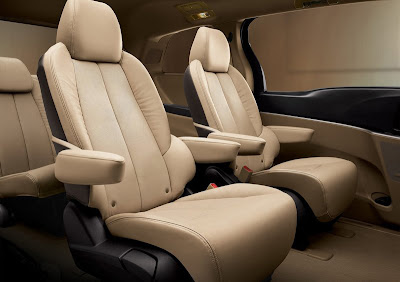Land Rover Discovery 4, 2010



The new, fourth generation of Land Rover's supremely versatile seven-seat vehicle gains a new name - Land Rover Discovery 4 - to go with its powerful and highly efficient new TDV6 diesel engine, fresh exterior identity and more premium cabin. The class-leading breadth of capability is extended even further with dynamic improvements for both road and off-road driving, and Land Rover has added a battery of user-friendly new technologies and features.
Star billing on the Land Rover Discovery 4 goes to the highly efficient and refined new LR-TDV6 3.0 twin turbo diesel engine. This delivers a 9 percent fuel economy improvement (EU combined cycle) and ten percent less CO2 emissions, at the same time as increasing power by 29%, all compared with the existing 2.7-litre engine. Torque increases even more, up 36% to 600Nm - believed to be the highest torque output of any 6-cylinder, production diesel, passenger vehicle engine in the world.
The power and torque are both accessible across the entire rev range, to deliver immediate throttle response and effortless cruising ability. The results include a 0-60mph time of 9.0 seconds, (0-100 km/h in 9.6 seconds), a 24 percent improvement over the 2.7-litre.
Land Rover's engineers have also transformed the on-road ride and handling for the new generation Land Rover Discovery 4, and even improved on the near-legendary off-road capabilities of its predecessor. The comprehensive changes include new suspension components, revised steering, larger brakes, improved traction control, and enhancements to the award winning Terrain ResponseTM system, which helps optimise the vehicle for virtually all on-road or off-road driving situations.
The iconic exterior design has been updated, most obviously with smoother and simpler surfaces at the front, including a new, more aerodynamic bumper. The sportier new lights help give the vehicle new character, and include LED technology front and rear. The sophisticated new front headlights include High Beam Assist, switching on or off, as conditions require.
The interior is completely redesigned, with a transformed dash and centre console, new seats and an array of new, user friendly features.
e-Terrain technologies boost economy and lower CO2 emissions
The new Discovery is packed with features aimed at reducing fuel consumption and reducing CO2 emissions. The new LR-TDV6 3.0 Sequential Turbo Diesel engine was designed from the outset to deliver class-leading fuel economy and improved low-end torque.
The parallel sequential turbocharging system of the 3.0-litre diesel makes use of its larger, primary turbo most of the time. The smaller secondary turbo remains dormant when higher power is not required, reducing pumping losses and consequently, fuel consumption. A highly efficient, third generation common rail injection system with piezo injectors and fuel metering, also makes a substantial contribution to fuel economy.
The new engine has been also been optimised for low-end torque as well as economy, making it possible to activate the lock-up clutch of the ZF HP-28 automatic transmission at lower speed. This reduces 'slip' in the hydraulic torque converter improving both fuel consumption and CO2 emissions. The higher torque at lower rpm also enables longer gearing for more economical cruising.
The Discovery incorporates several other energy saving features too. At standstill, the idle speed of the V6 has been reduced from 750rpm to 710rpm, giving a fuel saving without compromising refinement. An Intelligent Power Management System includes Smart Regenerative Charging, so whenever possible the alternator charges the battery when it is most economical to do so, such as when the car is coasting rather than accelerating.
Aerodynamic changes to the front end, with the revised front lower chin spoiler and new front wheel deflectors, help to reduce drag by increasing underfloor airflow.
The new air conditioning pump is driven through a clutch which disengages when the air conditioning is not in use reducing parasitic losses and delivering improvements in fuel consumption and CO2 emissions.
At the heart of the improvements introduced with Land Rover Discovery 4 is an exceptional and highly efficient new diesel engine. The LR-TDV6 3.0 sequential turbodiesel is based on the existing LR-TDV6 2.7-litre engine, but radically redesigned to deliver substantially higher performance, lower emissions and better fuel economy.
The 2.7-litre has won many admirers as one of the most refined diesels ever made. The new, twin turbocharger LR-TDV6 3.0 boasts substantial increases in both power - up 29 percent to 245PS - and torque, up 36 percent to 600Nm. The ability to deliver maximum torque at just 2,000rpm, combined with unparalleled throttle response, substantially enhances the Discovery's already acclaimed ability both on and off-road.
The new 3.0-litre diesel can significantly out perform its rivals by delivering 500Nm in only 500 milliseconds from idle. From the driver's perspective this means instantaneous access to 83 percent of maximum torque.
But despite this extra performance, engine emissions are dramatically reduced. When fitted with DPF, the new LR-TDV6 3.0 meets EU5 emissions requirements (not due to come into force until 2011) and with a CO2 figure of 244g/km, it undercuts the existing 2.7-litre automatic by ten percent. Fuel economy is also improved by 9 percent, delivering 30.4mpg (9.3 l/100km) on the EU Combined cycle.
The new 3.0-litre engine has been developed by a joint Jaguar Land Rover team, with base characteristics designed from the outset with the requirements of both brands in mind. High levels of torque and fast response from low revs perfectly suits both Jaguar and Land Rover DNA. The Jaguar version, the AJ-V6D Gen III S, was recently launched in the new Jaguar XF.
The LR-TDV6 engine has a deeper sump than its Jaguar sibling, to ensure the efficiency of the lubrication system is not compromised when venturing off-road. The oil scavenge system of the turbochargers has been enhanced for a similar reason, ensuring no oil collects in the turbochargers at extreme angles in off-road conditions.























